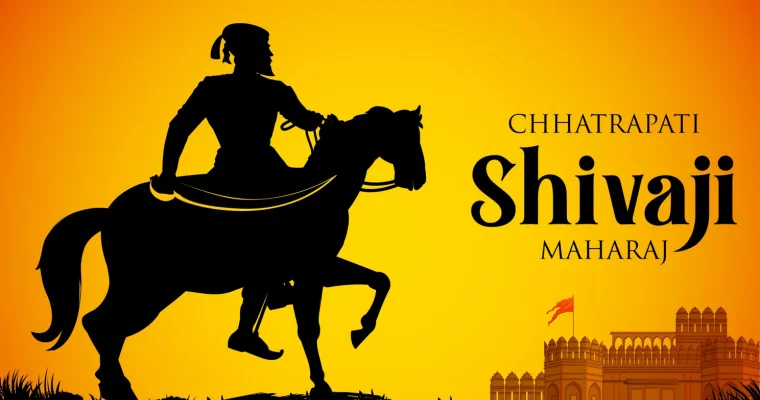
What can one say of a man, who from practically nothing created an empire, and whose legacy not only lives on in the heart of the people of India, well over three hundred years after his death in 1680, but grows stronger with each passing day. Born on 19 Feb 1630, Chhatrapati Shivaji Maharaj was one of those few leaders who captured the imagination of the people of his times and whose charisma endures till the present day, inspiring newer and newer generations of modern India.
Shivaji was born on 19 February 1630 to Shahaji, a nobleman who held high office under the Sultan of Bijapur. The family claimed descent both from King Porus, a ruler of a small state lying between the Jhelum and Chenab rivers and from the Ranas of Udaipur. Porus was the legendary King who halted the mighty Alexander in his tracks, in 326 BCE, in the First Battle of the Jhelum, also called the Battle of Hydaspes. After this battle, Alexander’s army refused to move ahead with the conquest of India and was forced to return from whence they had come.
When Shivaji was born, the Mughuls held sway over large parts of India. Mirza Shahab-ud-Din Muhammad Khurram, the fifth Mughal Emperor, also known as Shah Jahan, had taken over the throne of Delhi two years earlier, in 1628. While the Sultanates were independent entities, they owed allegiance to the Mughal ruler at Delhi. During those times, though a few Hindus held high office in the Muslim-ruled states, the masses were subjected to religious discrimination and persecution. Lacking a cohesive leadership, the Hindus who comprised the majority population, had resigned themselves to their fate.
Not so, Shivaji, who as a young lad, rebelled against this injustice. His father, fearing retribution from the Bijapur ruler, moved his young son out of Bijapur. It was Shivaji’s mother who took him back to his family estates, on the borders of Bijapur and the Mughal dominions. By the time he was 19 years old, Shivaji had established control over a few villages, the principal one being Poona. Thus began his journey to fulfilling his dream of establishing a Hindu kingdom. Starting with the conquest of small forts through guile and stratagems, he soon became a powerful figure to contend with. By the time of his death in 1680, He had established an independent empire, which stretched along the coast of West India to the coastal lands on the East. Subsequent rulers enlarged this empire, to cover nearly the whole of India.
Shivaji’s life inspired the rise of Hindu nationalism and made them shake off the yoke of Muslim hegemony. “Hindawi Swaraj” was his goal, and this instilled in the people, the courage to fight for freedom, and to take pride in their heritage and civilisational roots. Shivaji manifested exemplary qualities of frontline leadership, which endeared him to his people. He was a master planner, and none could compare with his bravery and chivalrous conduct in battle. Intelligent and quick-witted, it did not take him long to seek out the weaknesses in his opponents and exploit the same for battlefield success. Over time, Shivaji evolved from a master warrior into a warrior statesman.
The stories of Shivaji’s exploits are too well known to be recounted here. But what draws attention and great admiration was the difference with which he ruled his kingdom. While Muslim rule, especially that of Aurangzeb was filled with bigotry, Shivaji treated all people equally, regardless of their religious affiliations. His soldiers were warned to treat the captive Muslims with respect, and this extended especially to their women folk. A man of high ideals, Shivaji could never resort to religious bigotry. He was a Hindu King in a Hindu Kingdom, but he was not just a King for the Hindus but a King for all. Therein lay his greatness.
The latter part of Shivaji’s life was spent in fighting the armies of Aurangzeb. The fact that the forces arraigned against him were vastly superior to his own, never fazed him. When he died, he drew grudging praise from Aurangzeb who acknowledged Shivaji’s greatness. Aurangzeb had also contemptuously called Shivaji a mountain rat, but it was this ‘mountain rat’ that continued to nibble away at the Mughal empire, which, despite its might and resources, could not contain him. The later years of Aurangzeb’s long rule saw the withering away of his empire. With Aurangzeb’s death, the empire further dwindled and faded away.
Today, as the nation commemorates the 394th birth anniversary of Chhatrapati Shivaji Maharaj, it is also marching towards Amrit Kaal—a period denoting a golden era, the concept finding reference in ancient Indian Vedic texts. It is viewed as an auspicious period to initiate new endeavours. For us in India, the 25 year period, from 2022-2047 has been designated by Prime Minister Modi as Amrit Kaal, presenting an opportunity to gain our rightful place in the comity of nations. Marching towards this end with renewed optimism, hope and zeal, the example set by Chhatrapati Shivaji Maharaj, whose life was an embodiment of valour, courage and self-sacrifice, serves as an inspiration to India’s quest towards emerging as a major power and a developed nation by 1947, when India commemorates her centenary of being a free nation.






Add comment